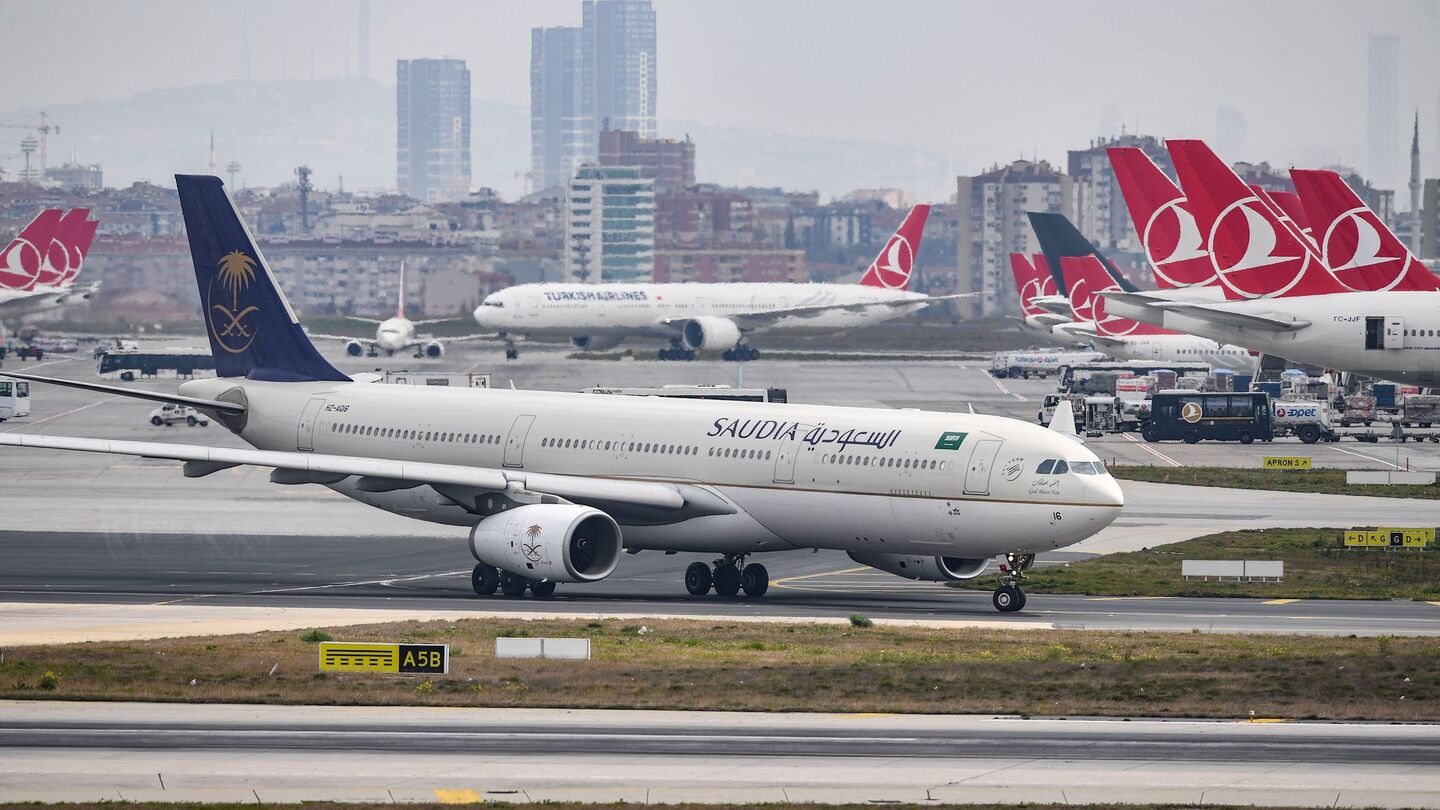
Soaring Competition: The Middle East’s aviation rebound takes off as Saudi Arabia challenges leading airlines
April 2023 Al-Monitor PRO Trend Report
3884 words
Introduction
Global travel is back, fueling resurgent passenger demand for the Middle East’s vaunted long-haul carriers. Al-Monitor estimates that the Gulf’s Big Three airlines — Qatar Airways, Emirates and Etihad — likely combined to carry over 65 million travelers in 2022, a huge rebound after COVID-19 shutdowns battered the sector. Simultaneously, key regional hubs once again ranked among the world’s busiest in 2022, with a combined 166 million travelers transiting through Dubai, Istanbul and Doha.
Now, a return to profitability is in sight for the region’s aviation sector in 2023 as industry players make up for years of lost growth. But that’s not the biggest storyline on the radar of industry watchers. “It has to be Saudi Arabia,” said John Grant, chief analyst with airline data provider OAG, who points to the kingdom’s rapid airport expansion, aggressive air service development, renegotiation of air service agreements and now — most notably — a brand new airline. In March 2023, Saudi Arabia unveiled Riyadh Air, a new national carrier set to take flight by 2025 and take intense competition to new heights.
This comes as the International Air Transport Association (IATA) predicts the Middle East will be one of the fastest-growing airline markets in coming years. The trade body forecasts that Middle Eastern carriers will deliver a profit of $268 million in 2023, which comes after regional players posted an expected loss of $1.1 billion in 2022. Globally, IATA projects that airlines will generate a small net profit of $4.7 billion in 2023, after seeing losses of $6.9 billion in 2022, $42 billion in 2021, and $137.7 billion in 2020. That would mark the industry’s first profit since recording $26.4 billion in 2019. However, the industry’s financial recovery remains fragile. Although countries have eased pandemic travel restrictions, 2022 also saw increasing geopolitical tensions and inflationary pressure. Add rising competition into the mix alongside other factors — from pilot shortages to decarbonization — and a continued recovery could be bumpy.
1. State of Play: profits and passengers reappear
The Middle East’s aviation sector continues ascending from pandemic lows: key regional airlines posted record financial results during 2022 as capacity started to approach pre-COVID levels again. Regional aviation benefitted somewhat from rerouting caused by the war in Ukraine, according to IATA, but the more significant driver was pent-up international travel demand facilitated by the region’s extensive global networks. Plus, Qatar’s World Cup — which drew over 1.4 million fans — provided a nice boost.
Regional travel hubs returned to rank among the top 10 busiest airports globally in 2022, according to the annual list published by Airports Council International World (ACI). Dubai ranked 5th globally in 2022 after welcoming 66.1 million passengers, a 127% increase from 2021. That was still down 23.5% from 2019, but also saw it reappear in ACI’s top 10 after tumbling out during the pandemic as international traffic plummeted. Not surprisingly, Dubai retained its crown as the busiest hub for international passengers in 2022, a distinction it also managed in 2021 despite recording only about 29 million travelers (up 12.7% compared to 2020).
Meanwhile, Istanbul was the world’s 7th busiest airport in 2022, welcoming 64.3 million passengers, a 73.8% increase. In terms of international passengers, Istanbul was 5th with 48.5 million, up 83.3% from 2021 and 22.6% from 2019. Although not among the top 10 busiest overall, Doha ranked 8th for international travelers, welcoming 35.7 million, up 101.8% from 2021 and down 7.9% from 2019.
Other regional airports failed to crack ACI’s top 10. That notably includes Saudi Arabia, which lacks a major global transit hub like Gulf neighbors — but that could change, as the kingdom harbors a goal to serve 330 million passengers and attract 100 million visitors annually by 2030. In November 2022, Saudi Crown Prince Mohammed bin Salman announced plans to upgrade the existing Riyadh airport into a much larger hub able to accommodate up to 120 million travelers by 2030.
Currently, Jeddah’s King Abdulaziz International Airport is the kingdom’s busiest, welcoming about 32 million passengers in 2022, compared to 14 million in 2021, according to Saudi Arabia’s General Authority for Statistics. Riyadh’s King Khalid International Airport was second, with about 27 million, up from 17 million in 2021. Meanwhile, roughly 88 million passengers traversed Saudi airports in 2022, an 82% increase. That included 41.7 million international passengers, a 198% increase.
Powering those results was the kingdom’s current flag carrier Saudia, which transported 25 million passengers in 2022 with a fleet of 142 aircraft. In April, Saudia reported that it transported 7 million guests in Q1 2023, including 3.8 million international travelers. Although the state-owned airline didn’t reveal statistics for 2021 or 2020, it reported 11.6 million passengers during H1 of 2022, an 80% increase over H1 2021. Saudia hasn’t revealed financials, but in May 2022 its CEO Ibrahim Koshy said the airline could return to profitability later that year or in 2023. Saudia currently serves over 100 destinations and in March 2022 announced it will add 25 new international ones in 2023, ranging from Beijing to Johannesburg.
Still, those developments have been overshadowed by Riyadh Air, the new premium airline launched in March 2023 by the kingdom’s Public Investment Fund (PIF). The new carrier also revealed an order for 72 Boeing 787 Dreamliners, which came as Saudia also announced its intent to purchase up to 49 Dreamliners to grow its long-haul fleet. Combined, the deals are worth nearly $37 billion.
That’s upping the competitive stakes, but Riyadh Air’s future rivals have also been rebounding — particularly Emirates, the Gulf’s largest carrier. As of this writing, the Dubai-based airline hasn’t released full results for its 2022-2023 financial year, but in November 2022 it reported profits of $1.1 billion during the year’s first half, a company record. In H1 of 2021 it recorded a $1.6 billion loss. The airline also generated revenues of $13.7 billion, up 131% from H1 2021, while carrying 20 million passengers, up 228%.
This comes after reporting a $1.1 billion loss during the full 2021-2022 financial year, which was five times lower than the year before, when it posted its first annual loss in over three decades. The airline, which has a fleet of 262 aircraft, carried 19.6 million passengers during the 2021-2022 financial year, up from 6.6 million the year prior.
As of September 2022, Emirates operated passenger and cargo services to 140 airports. Meanwhile, operating costs increased 73% compared to capacity growth of 40% between March and September 2022, which it blamed on fuel costs more than tripling. During that same period the group’s employee base grew 10% to reach 93,893, which came as part of a recruitment drive following significant pandemic layoffs. Although it received two new Boeing 777 freighters in 2022, Emirates isn’t expected to receive new passenger aircraft until 2024 and last year began a $2 billion retrofit program.
Qatar Airways, the Gulf’s second largest airline, posted a record net profit of $1.54 billion for its 2021-2022 financial year — its first annual profit since 2017, when regional neighbors imposed a diplomatic blockade. That return to profitability was 200% above its highest annual historical record, achieved on the back of $14.4 billion in overall income. The state-owned airline, which flies to over 160 destinations, transported 18.5 million passengers in 2021-2022, an increase of 218% over the previous year. The Doha carrier also said its cargo division remained the world’s leading player, with 25% revenue growth. This comes after Qatar Airways lost $4.1 billion in the 2020-2021 financial year.
Then there’s Turkish Airlines, which reported a net profit of $2.7 billion in 2022 and enjoyed its sixth consecutive profitable quarter. Total revenue hit a record high of $18.4 billion, surpassing its pre-pandemic 2019 sales by 39%. The airline carried around 72 million passengers last year with a fleet of 394 aircraft. Cargo accounted for 20% of total revenues, with the airline reporting it has quadrupled its market share in the air freight market in the last decade. Between January and March 2023, the airline carried 17.1 million passengers, compared to 12.7 million during the same period in 2022.
Finally, the UAE's other flag carrier, Etihad Airways, revealed a record core operating profit of $296 million during H1 2022, which followed a $392 million loss in H1 2021. Its fuel costs increased by almost 60% compared to H1 2021, but its passenger revenues tripled, climbing to $1.25 billion. Although it hasn’t announced full 2022 results as of this writing, it carried 10 million passengers last year. Elsewhere, key budget carriers posted strong results, such as Flydubai and Air Arabia, which both announced 2022 profits of $327 million apiece, while carrying a combined 23.4 million passengers.
2. Evolving airspace relations
As the aviation sector rebounds, the Middle East is seeing breakthroughs in airspace relations alongside new tensions. For instance, news surfaced in March 2023 that India was resisting calls from Middle East airlines to increase the number of flights that can arrive from the region, with the UAE wanting to increase the seats available between the two countries from 65,000 a week to 115,000.
This emerged during the CAPA India Aviation Summit in New Delhi, when the president of Emirates, Tim Clark, said that the limit should be increased. The CEO of Kuwait’s Jazeera Airways, Rohit Ramachandran, also called for an increase in the air traffic limit between India and Kuwait, while Turkish Airlines CEO Bilal Eksi made similar remarks, saying current availability between Turkey and India was insufficient to meet demand. However, India’s Civil Aviation Minister Jyotiraditya Scindia told Reuters that an increase was not being considered at that time.
Flights between the Gulf and India are important due to the region’s large South Asian population: over 3 million Indians live in the UAE, while roughly another million live in Kuwait. Many Indians also travel to the Gulf for business and tourism, with the UAE the top destination for Indian tourists in 2021. Simultaneously, Air India is making a massive push to expand its global presence. In February 2023, it announced agreements with Airbus and Boeing to acquire a total of 470 aircraft — a historic order. That’s positioning Air India’s long-haul routes to compete with Gulf carriers, allowing travelers to bypass the region. The first of its new aircraft are supposed to enter service in late-2023.
That said, airspace cooperation is also progressing in the region on other fronts. In February 2023, Oman announced that it would open its airspace to all carriers that meet the safety requirements of its civil aviation authority, including Israel. Although the announcement didn’t refer to Israel specifically, it still means its aircraft will be authorized to fly through Omani skies.
Hailing the announcement, Israel's Foreign Minister Eli Cohen said that the "historic decision will shorten the road to Asia, lower costs for Israeli citizens and help Israeli airlines to be more competitive." The US also welcomed the move, crediting the White House’s diplomatic engagement on the issue.
Oman’s decision is just the latest facilitating regional air travel involving Israel, which had been an aviation “dead end” for most of its existence due to regional hostilities. However, the Abraham Accords in 2020 paved way for diplomatic efforts to open up the region’s airspace. Israel and the UAE quickly agreed to establish routes after establishing relations: Israeli flag carrier El Al began daily flights to Dubai in December 2020 and Emirates launched its service to Tel Aviv in 2022.
In July 2022, Saudi Arabia also authorized all carriers that met its requirements for overflights to pass through its airspace. The Saudi announcement also didn’t mention Israel, but the result was the same. That came after Saudi Arabia first allowed flights between the signees of the Abraham Accords — Israel, Bahrain and the UAE — to pass through its airspace. Elsewhere, Israel allowed El Al to resume direct passenger flights to Turkey in 2023, which had been suspended since 2007 over security concerns (although the Israeli carrier resumed cargo flights in 2020). That came after Turkey and Israel reached an initial accord in July 2022 that paved way for the move.
Meanwhile, in March 2023 the UAE and Iran agreed to work together more on aviation matters, Iranian state media reported. Iranian Civil Aviation Organization spokesman Jafar Yazarloo said they signed a memorandum of understanding with the UAE’s General Civil Aviation Authority. They specifically aim to increase the number of flights between Iran and the UAE, alongside boosting the number of flights through Iranian airspace, the official Islamic Republic News Agency reported.
3. Outlook: a competitive rebound
• After clawing back from the depths of pandemic losses in 2022, the Middle East’s aviation sector is poised for its first profits since 2017, according to IATA data. The trade body currently forecasts regional net profits of $268 million in 2023, with airlines returning to serve 97.8% of pre-crisis demand levels and 94.5% of capacity.
• Industry watchers are optimistic that the Middle East's aviation sector will continue recovering in 2023. “I’m bullish. We see strong demand for connecting traffic via the Gulf hubs,” said John Strickland, an aviation analyst and director of JLS Consulting. Strickland also noted that Dubai has shown a strong recovery for point-to-point business and tourism traffic.
• China’s reopening is also positioning Gulf hubs to continue benefitting from increased international traffic. “The region acts as a pivot for travel demand from Europe to Asia and that will be a solid basis for growth and also of course the rapid development of the emergent markets in Central Asia and East Africa,” said OAG’s Grant.
• “Cautiously optimistic” is how Linus Benjamin Bauer, the founder of Dubai-based Bauer Aviation Advisory, describes his outlook for the Middle East's aviation sector in 2023, pointing to growth being driven by both leisure and business travel, while also highlighting the region's strategic location and strong connectivity making it an attractive hub for passengers.
• Still, the horizon isn’t without headwinds and consumers have been tolerating huge airfare increases amid inflationary pressures. There are several threats to strong growth for regional airlines currently, as IATA’s Middle East chief Kamil Al-Awadhi told Al-Monitor in April 2023. These include high fuel prices alongside high operating costs, including taxes and fees. Fuel prices also jumped following the surprise decision by OPEC+ to cut output in early April.
• Furthermore, economic volatility and recessions will also impact travel demand in the region, according to IATA’s Al-Awadhi, who also pointed out challenges facing North African carriers: namely, around $1.6 billion is being withheld in various African countries — including Algeria — due to currency shortages and other issues. In April 2023, IATA warned that the blocked funds could lead to airline disruptions if the talks to unfreeze the money owed to carriers don’t proceed.
• Gulf states flush with cash from renewed oil revenues can continue investing in their aviation sectors—as Saudi Arabia is already doing, which should see more moves from Riyadh Air in coming months as it develops its fleet. Simultaneously, the kingdom’s rising aviation ambitions should galvanize regional rivals to sharpen their competitive edges.
• As airlines in the Gulf recover from the pandemic and await Riyadh Air’s entrance, Qatar Airways Group CEO Akbar Al Baker in April described competition in the sector as the survival of the fittest during an interview with CNN.
• Although rising competition is heightening regional airline rivalries, thawing ties are another factor to consider. “We see an improved political climate in a number of areas including the opening of flights to Israel from the UAE for example, the end of the Qatar blockade and improving relations between Saudi and Iran,” said Strickland.
• Another big trend to watch is sustainability. “In response to global pressure to reduce the environmental impact of aviation, Middle Eastern airlines and airports are prioritizing sustainability initiatives,” said Bauer. Those include adopting energy-efficient technologies, investing in alternative fuels and implementing carbon offset programs. “Furthermore, the region's airlines are gradually modernizing their fleets with next-generation, fuel-efficient aircraft,” said Bauer.
• The UAE’s flag carriers will also be in the spotlight when the country hosts COP28 in 2023, as decarbonization of aviation should be an important topic. Although still nascent, regional airlines are exploring paths towards cleaner air travel, with Etihad Airways flying from Washington, DC to Abu Dhabi in late 2022 using sustainable aviation fuel (SAF). The upcoming climate summit offers an ideal platform to position the UAE as a key proponent of a cleaner future for the industry.
• That said, COP28 may just as easily see additional charges of greenwashing aimed at Gulf airlines. For example, Etihad had two advertisements blocked in the UK in April 2023 after the country’s Advertising Standards Authority ruled that the airline “exaggerated” the environmental benefits of flying with them.
• Technological advancements are another key trend that BAA’s Bauer is tracking, as Middle Eastern aviation players are actively investing in innovative technologies such as artificial intelligence, biometrics and blockchain. “These technologies are being integrated into various aspects of aviation operations, from passenger check-ins to baggage handling and aircraft maintenance,” said Bauer.
• Finally, recruitment is another factor to watch, as regional airlines are expected to face pilot shortages in coming years. Players are likely to invest in developing talent, as Emirates did in February 2023 when it announced a $135 million pilot training facility, slated to open in March 2024.
4. Case study: Riyadh Air
Saudi Arabia’s aspiration to launch another airline had circulated for years before finally taking shape in 2023, with Crown Prince Mohammed bin Salman seeing aviation as a key component of the kingdom’s Vision 2030 economic reform agenda.
That saw Riyadh Air revealed in March 2023, with the new national carrier wholly owned by the PIF. The airline is expected to serve Africa, Europe and Asia and connect to over 100 global destinations by 2030. The PIF stated that the airline’s goals are to improve traveler connections to Saudi Arabia’s cultural and natural attractions, create over 200,000 jobs and add $20 billion to non-oil gross domestic product.
"Our stated commitment is to create a world-class airline and this partnership with Boeing in building the fleet is the next step in achieving the aspirations of Saudi Arabia as a global transportation hub," said the new airline’s chairman Yasir Al-Rumayyan (who is also the PIF’s governor) at the time.
Only days after unveiling the new carrier, the kingdom announced two agreements to purchase up to 121 Boeing 787 Dreamliners, with 72 intended for Riyadh Air and 49 for Saudia. The $37 billion price tag of the combined deals comprises the fifth-largest commercial order by value in Boeing’s history.
At the time, the deal was seen as a sign of improving relations between Washington and Riyadh after President Joe Biden last year spoke of "consequences" following disappointment with Saudi Arabia’s decision to cut oil production. The White House hailed the agreements as "historic” and “another milestone in eight decades of cooperation between Saudi Arabia and American industry.” Mere weeks later Saudi Arabia and OPEC+ members announced plans to reduce output again, pushing oil prices higher and serving up another challenge to the Biden administration.
At Riyadh Air’s helm is Tony Douglas, the former CEO of Etihad, who left the Abu Dhabi carrier in October 2022 to pursue an unspecified opportunity, Reuters reported at the time. Saudi Arabia's new national airline plans more aircraft orders this year as it prepares to operate its first flights in early 2025, Douglas told AFP in March.
The new airline is also pivotal to Saudi efforts to turn Riyadh into a regional travel hub rivaling Dubai and Doha. Key to that will be redeveloping its airport into a larger hub for its new airline. Set to be renamed King Salman International Airport, it will cover 57 square kilometers (or 22 square miles).
Still, analysts have questioned the feasibility of the kingdom’s plans for Riyadh Air, with some describing the regional market as already "saturated." However, the Saudi strategy hinges partly on tapping domestic demand in a country with roughly 36 million inhabitants, which officials see as a major advantage over smaller Gulf rivals dependent on international flights.
"This is a statement of intent by the kingdom. This is about a brand of Riyadh,” said Douglas. “This is about the hub being here in the capital city. And this is about allowing the kingdom to have better connectivity to the world and, as importantly, the world to have better connectivity to the kingdom.”
5. Key takeaways
➡ The Middle East is poised to be one of the fastest-growing airline markets in the next decade, with sweeping economic transformation plans adopted by many Gulf countries set to stimulate air traffic in coming years, IATA’s Al-Awadhi told Al-Monitor. Management consulting firm Oliver Wyman projects traffic growth in the Middle East will grow 6.4% between 2023-2033, the top rate globally outside of Latin America.
➡ That trend will largely be driven by the economic growth of Saudi Arabia, the UAE and Qatar, alongside the GDP growth of major source markets that regional airlines service, such as the Indian sub-continent, China and Asia Pacific, reported Al-Awadhi. “In addition, the Middle Eastern countries are engulfed in large multidimensional economic and social transformation programs, investing in industries away from hydrocarbons, liberalizing visas and facilitation, and focusing on greater connectivity and tourism numbers," said Al-Awadhi.
➡ Although current and future challenges can impact growth, the Middle East’s aviation industry has managed to emerge from recent turbulence on strong footing. “This resilience, combined with the industry's adaptation to new technologies and focus on sustainability, bodes well for continued recovery,” said BAA’s Bauer. That said, a global recession could dampen air travel demand and pinch expected profits, but it would likely take a resurgent pandemic and more shutdowns to truly threaten growth.
➡ Looking ahead, Saudi Arabia’s efforts to advance as a global hub will loom large. Riyadh Air’s push to challenge existing powerhouse aviation brands should set the stage for fiercer competition, ushering in a new era of cutting-edge first class and business offerings alongside other innovative travel experiences.
➡ Headlined by Riyadh’s giant new airport, regional countries are also investing heavily into expanding and upgrading their infrastructure on the ground to support growing demand and enhanced connectivity. “This includes constructing new terminals, upgrading existing facilities, and building new airports altogether,” said Bauer. “These developments aim to enhance the region's status as a global aviation hub, catering to both passenger and cargo traffic.”
➡ More aircraft orders are inbound. Oliver Wyman projects that the Middle East’s fleet will grow by 5.1% annually over the next decade. That trend will be driven by narrowbody aircraft, in contrast to the region’s historical preference for widebodies, which are forecast to decline from 56% of local fleets to 48% over the next decade.
➡ Carbon emission regulations could certainly impact further industry growth and investment in the region. A key trend to watch is the production capacity of SAF, which remains expensive compared to conventional jet fuel. However, leading Gulf airlines are already experimenting with SAF, positioning them to potentially become industry trendsetters if they decide to commit further and help create market momentum for cleaner fuel. For now, that remains very much up in the air.
We're glad you're interested in this trend report.
Trend Reports are one of several features available only to PRO Expert members. Become a member to read the full memos and get access to all exclusive PRO content.
Join Al-Monitor PRO Start with a 1-week trial.

